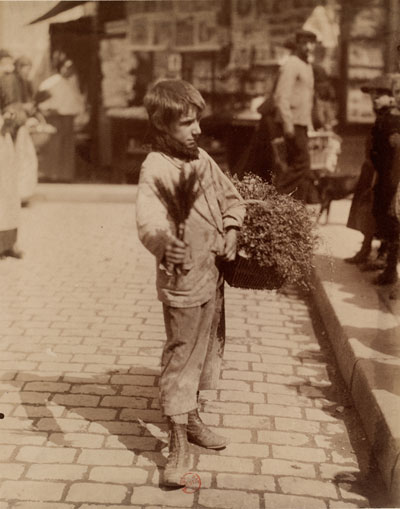 Marchand d'herbes, Paris, 1898 (Kräuterhändler) Serie: Paris pittoresque, 1. Serie Albumin-Abzug, 24 x 18 cm © BnF, Estampes et Photographie Eugène Atget Paris um 1900 Click for English text Retrospektive "Kein Diskurs über die Fotografie, keine Geschichte des Mediums ohne Atget, den einzigartigen Künstler am Ende des 19. und zugleich Pionier des 20. Jahrhunderts." (Aubenas / Le Gall) Eugène Atget (1857-1927) zählt zu den grössten Fotografen des 20. Jahrhunderts. Berühmt geworden ist er vor allem durch seine Ansichten des "alten Paris", die schon zu seinen Lebzeiten bei Sammlern begehrt waren und vielen Malern als Vorlagen für ihre Werke dienten. Dem alten Paris, dem Vor-Haussmannschen-Paris galt seine ungeteilte Aufmerksamkeit. Zu Lebzeiten nur einem engen Kreis von Historikern, Künstlern und Konservatoren von Museen und Bibliotheken bekannt, hielt Atget in unermüdlicher Arbeit den Teil des alten Paris mit seiner Kamera fest, der im Verschwinden begriffen war: Denkmäler, pittoreske Winkel der Stadt und versteckte Innenhöfe, aber auch Schaufensterauslagen, Ladenschilder und Türklopfer, Strassenhändler, Prostituierte und Jahrmarktsbuden - und nicht zuletzt die romantischen Landschaften des Parc de Saint-Cloud in der Umgebung von Paris. Es sind Bilder, die von einem besonderen Gespür für das Kulturerbe zeugen. Erst kurz vor seinem Tod erkannte man seinen singulären Rang, verstärkt ab den dreissiger Jahren wurde er zum Vorbild und zur unerschöpflichen Quelle der Inspiration für so unterschiedliche Fotografen wie Berenice Abbott, Walker Evans, Lee Friedlander, Robert Doisneau, Bernd und Hilla Becher. So übte er nachhaltigen Einfluss auf die Fotografie des 20. Jahrhunderts aus. Der in Anlehnung an den naiven Maler Henri Rousseau oft als "Rousseau der Fotografie" bezeichnete Atget wurde schon früh von Robert Desnos, Walter Benjamin und den Surrealisten gefeiert. Diese von der Bibliothèque nationale de France und den Kuratoren Sylvie Aubenas / Guillaume Le Gall anlässlich von Atgets 150. Geburtstag und 80. Todestag zusammengestellte Ausstellung und das begleitende Buch präsentieren eine umfassende Synthese seines umfangreichen Werks und lassen das alte Paris in wunderbaren Bildern an uns vorbeiziehen. Die Ausstellung umfasst rund 350 Werke. Sie wird parallel zur Ausstellung "Jedermann Collection - Set 5 aus der Sammlung des Fotomuseum Winterthur" gezeigt. Eine Ausstellung, die die konzeptuelle Fotografie der 1960er und 1970er vorstellt - mit Werken von Künstlerinnen und Künstlern, die sich mehrheitlich auf Atget beziehen. Wir zeigen also nicht nur eine umfangreiche Retrospektive von Eugène Atget, sondern wir zeigen auch die umfangreichen Folgen und Auswirkungen seines Werkes. Eine einmalige Gelegenheit, die Spannbreite der Fotografie im 20. Jahrhundert mitzuerleben. Eine Ausstellung der Bibliothèque nationale de France - Galerie de photographie. Publikation: "Eugène Atget - Retrospektive". Nicolai Verlag, Bibliothèque nationale de France und Berliner Festspiele. Mit Texten von Sylvie Aubenas, Guillaume Le Gall, Laure Beaumont-Maillet, Clément Chéroux und Olivier Lugon. 288 Seiten, rund 280 Duplexabb., Format 25 x 29,3 cm, Hardcover mit Schutzumschlag. Mit Unterstützung von Champagne Louis Roederer Hauptsponsor: UBS AG Ausstellungsdauer 1.3. - 25.5.2008 Oeffnungszeiten Di-So 11 - 18 Uhr, Mi 11 - 20 Uhr Montag geschlossen Fotomuseum Winterthur Grüzenstrasse 44 + 45 8400 Winterthur Telefon +41 (0)52 234 10 60 Fax +41 (0)52 233 60 97 Email fotomuseum@fotomuseum.ch www.fotomuseum.ch Eugène Atget Paris c. 1900 Retrospective "No discourse about photography, no history of the medium without Atget, the unique artist at the end of the 19th and, at the same time, pioneer of the 20th century." (Aubenas / Le Gall) Eugène Atget (1857-1927) is one of the greatest photographers of the 20th century. He became famous primarily through his views of the "old Paris", which were coveted by collectors even during his lifetime, and which served numerous painters as sample prints for their work. The old Paris, the pre-Haussmann Paris, was the subject of his undivided attention. Known only to a small circle of historians, artists and curators during his lifetime, Atget worked tirelessly at capturing with his camera the part of old Paris that was in the process of disappearing: monuments, picturesque corners of the city and hidden courtyards, as well as window displays, shop signs and door knockers, street traders, prostitutes and fairground stalls - and, last but not least, the romantic landscapes of the Parc de Saint-Cloud in the environs of Paris. These are pictures that reveal an exceptionnal feeling for the cultural heritage. It was only shortly before his death that his unique status was recognised, and from the 1930s on he became a model and inexhaustible inspiration for photographers as different as Berenice Abbott, Walker Evans, Lee Friedlander, Robert Doisneau, Bernd and Hilla Becher. Thus he had an enduring influence on 20th century photography. Atget, who was often referred to by the naïve painter Henri Rousseau as the "Rousseau of photography" owing to his affinity with the latter's work, soon made his mark on Robert Desnos, Walter Benjamin and the surrealists. This exhibition, compiled by the Bibliothèque nationale de France with the curators Sylvie Aubenas / Guillaume Le Gall on the occasion of the anniversary of Atget's 150th birthday and the 80th anniversary of his death, presents an extensive synthesis of his work and lets the old Paris glide before us in wondrous pictures. The exhibition is accompanied by a book. The exhibition consists of around 350 works. It is shown parallel to the exhibition "Jedermann Collection - Set 5 from the Fotomuseum Winterthur Collection", an exhibition that introduces the conceptual photography of the 1960s and 70s, with contributions by artists whose work evidences frequent references to Atget. Thus, in addition to the comprehensive retrospective of Eugène Atget's photography, we are also showing the extensive influences and consequences of his work. A unique opportunity to experience the span of photography in the 20th century. An exhibition by the Bibliothèque nationale de France - Galerie de photographie, with the support by Champagne Louis Roederer Main sponsor: UBS AG Exhibition 1 March - 25 May 2008 Opening hours Tues-Sun 11 am - 6 pm, Wed 11 am - 8 pm Closed on Mondays |